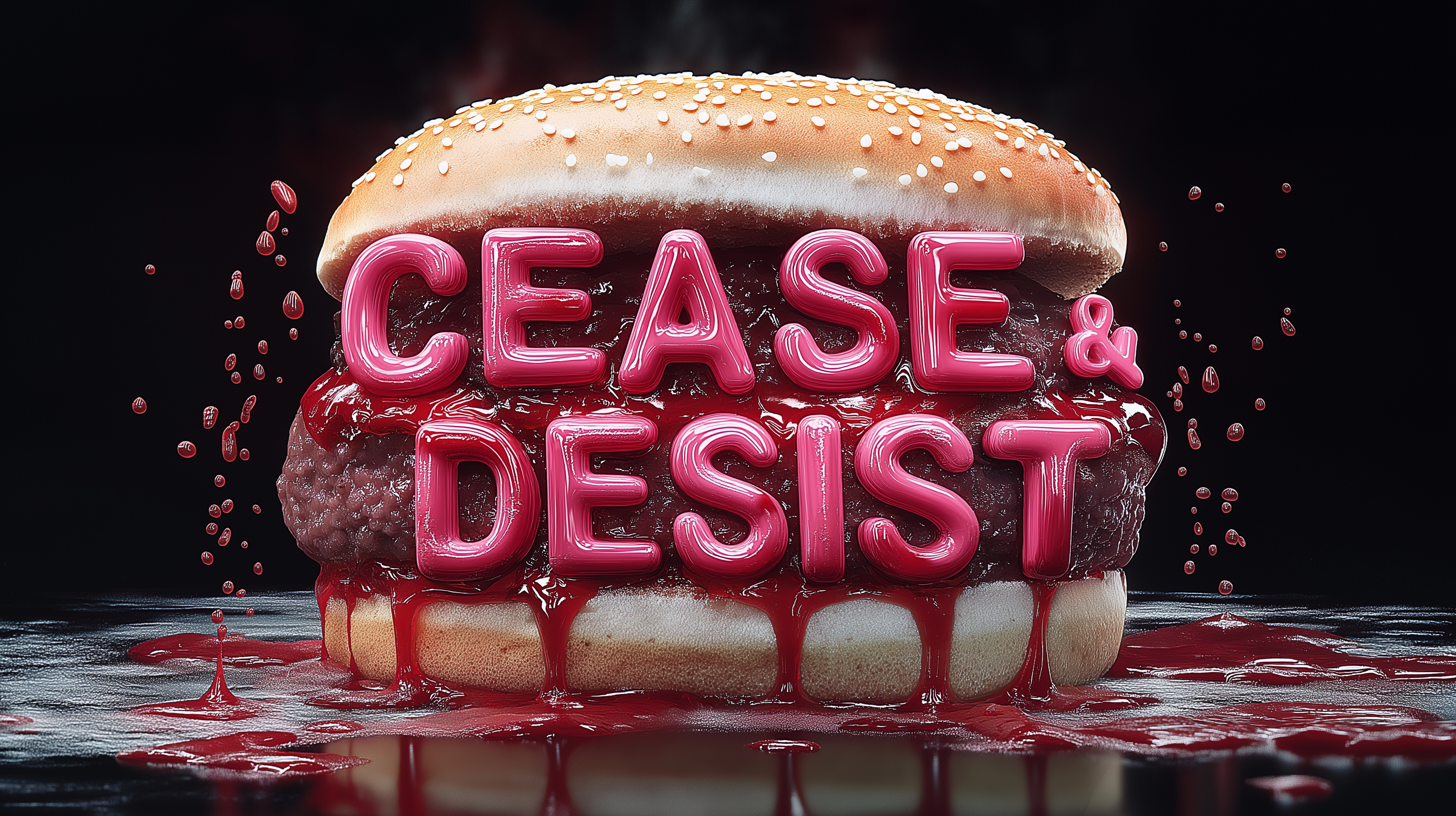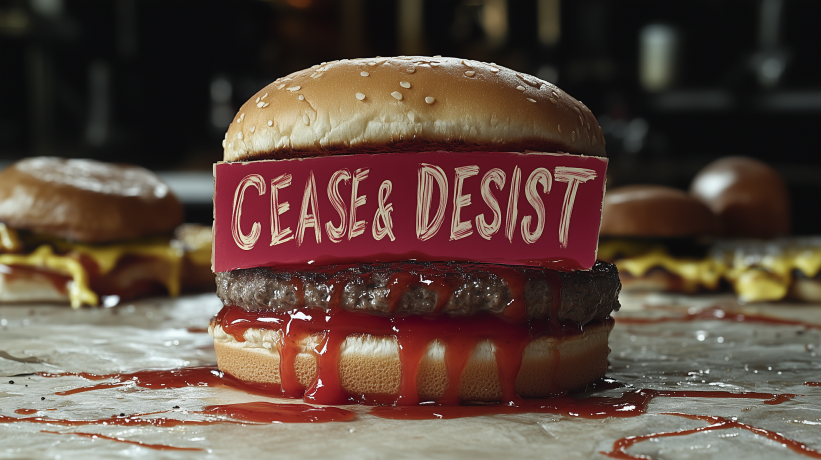
In-N-Out Burger's cease-and-desist letter to San Diego's Fairplay sports bar over trademarked menu items sparked a creative response. Fairplay quickly rebranded their "Animal Fries" and "Double Double," showcasing the importance of trademark awareness and agile brand management for restaurants.
by LawInc Staff
September 20, 2024
Recent news coverage by FOX 5/KUSI San Diego and Sandiegoville has highlighted a legal clash between fast food giant In-N-Out Burger and popular San Diego sports bar Fairplay over the use of trademarked menu item names “Animal Fries” and “Double Double.”
Fairplay’s lighthearted response to the cease-and-desist letter and quick rebranding of the dishes illustrate important lessons for restaurant owners on navigating trademark disputes.
This guide delves into key takeaways from the In-N-Out/Fairplay situation and similar cases, exploring issues such as trademark infringement, brand protection, responding to legal notices, and developing distinctive restaurant identities. By understanding the intellectual property landscape and best practices, restaurant professionals can mitigate legal risks and build strong, enduring brands.
1. Understand What Constitutes Trademark Infringement
-
- Avoid Using Identical Names: Duplicating trademarked menu item names, like Fairplay’s use of “Animal Fries” and “Double Double,” is a clear infringement.
- Be Wary of Confusingly Similar Names: Even if not identical, names that are likely to confuse customers about the source of goods can infringe on trademarks.
- Don’t Assume Smaller Scale Provides Protection: Trademark rights are enforceable against infringers of any size, as Fairplay learned.
- Realize Parodies Can Still Pose Problems: While Fairplay ultimately switched to parody names, those can still sometimes create confusion and legal issues.
- Consider Likelihood of Enforcement: Well-known brands like In-N-Out are more likely to take action to protect their marks than smaller entities.
Examples:
-
- Calling a signature burger the “Whopper” or “Big Mac” would clearly infringe on Burger King’s and McDonald’s famous trademarks.
- Dubbing a chicken sandwich the “Chick-fil-B” could confuse consumers by sounding very similar to the Chick-fil-A name.
- A hole-in-the-wall diner can still violate KFC’s marks by calling a menu item the “Famous Bowl” or using “It’s Finger Lickin’ Good” as a slogan.
- Parody names like “Burger Queen” or “Taco Smell” may avoid infringement but could still draw legal scrutiny for mocking known brands.
- Using “Frappuccino” on a menu would likely provoke Starbucks but a local cafe may get away with copying lesser-known chain menu item names.
How to Proceed:
-
- Audit your menu to identify any dishes that directly copy well-known trademarked names from other eateries and rebrand them.
- Put yourself in the customer’s shoes to assess if any of your menu item names could likely be confused with another restaurant’s signature dish.
- Recognize that your small size won’t shield you from potential infringement claims if your name use creates confusion in the marketplace.
- Tread carefully with parody names that directly reference and mock well-known menu items, as the parody defense has limits if confusion is still likely.
- Realize that the more famous the brand you’re imitating, even unintentionally, the higher the chances of legal action against you.
FAQs:
-
- Is it okay to use a trademarked name if I’m not a direct competitor? No, trademark infringement can occur even if the infringing use is for a different type of food service operation.
- Can I be sued for accidentally using a name similar to another restaurant’s? Yes, if your name causes a “likelihood of confusion,” it may be infringing even if not identical or deliberate.
- How do I know if a menu item name is trademarked? Search the federal trademark database, look for “TM” or “®” symbols on menus/ads, and be cautious with names synonymous with famous brands.
- What if a chain only operates in another state? Federal trademarks are enforceable nationwide, so don’t assume geographic separation protects you from infringement liability.
- Should I get a trademark for my restaurant name and signature dishes? It’s wise to consider trademarking your key brand assets, and registration provides expanded rights, but first ensure you’re not infringing on others.
View this post on Instagram
2. Address Cease-and-Desist Letters Promptly & Properly
-
- Don’t Ignore It: Failing to respond to a cease-and-desist notice can escalate legal troubles and damages. Engage with the sender promptly.
- Assess the Claims Objectively: Put emotions aside and honestly evaluate if your name use could be confusing or infringing as alleged.
- Consult an Attorney: Have an experienced trademark lawyer review the letter and advise you on your rights, obligations, and smartest response strategy.
- Reply in a Timely, Professional Manner: Once you’ve determined your position, send a response calmly addressing the claims and your planned actions by the sender’s deadline, if any.
- Follow Through on Your Commitments: As Fairplay did, if you agree to change infringing names, do so thoroughly and quickly to avoid escalation.
Examples:
-
- After getting a C&D from In-N-Out, Fairplay owner reached out immediately to start a dialogue, showing respect for the claim and legal process.
- Fairplay reflected on their use of “Animal Fries” and “Double Double” and recognized customers would likely connect them to In-N-Out’s iconic offerings.
- Though they felt the C&D was a sign of their success, Fairplay wisely sought counsel to guide their response and avoid rash moves or admissions.
- Fairplay’s owner communicated promptly with In-N-Out to acknowledge the letter, explain their corrective plans, and reaffirm respect for the brand.
- By fully implementing name changes swiftly after agreeing to do so, Fairplay kept the situation amicable and avoided a costly infringement suit.
How to Proceed:
-
- Open and read cease-and-desist letters as soon as you receive them – don’t let them sit unopened out of fear or denial.
- Gather your team to objectively analyze whether the accusations could have merit based on your actual name use and the applicable law.
- Discuss the letter with a trademark attorney to understand your options and develop a smart, cost-effective approach tailored to your situation.
- Respond to the letter sender meaningfully before the reply deadline, professionally addressing the concerns raised and your intentions.
- Make any name changes you’ve agreed to rapidly and completely across all platforms – website, menus, signage, ads, social media, etc.
FAQs:
-
- Can I just ignore a cease-and-desist letter? No, that will likely escalate the matter and could make you look willful if infringement is found, increasing legal risks.
- What if I think the accusations are baseless? You can explain in your response why you believe there’s no infringement, but still take it seriously and consult counsel.
- Should I call the sender to discuss? It’s best to keep communications in writing, so reply via letter or email and seek attorney guidance before discussing by phone.
- How long do I have to make name changes? Aim to complete the transition within 1-2 weeks if possible to show good faith and avoid a lawsuit being filed.
- What if I can’t afford an attorney? It’s risky to handle a C&D solo, so research free/low-cost legal resources like law school clinics or pro bono programs for advice.
3. Prioritize Original Branding & Menu Creativity
-
- Develop Distinctive Restaurant & Dish Names: Avoid legal troubles by prioritizing originality and steering clear of imitating others, even in jest.
- Focus on Your Own Identity: Let your restaurant’s unique story, theme, and culinary point of view drive name ideation, not copycats.
- Imagine Your Brand as an Empire: Choose names you’d be proud to trademark and expand to multiple locations, products, etc.
- Brainstorm Without Boundaries First: Start concepting names freely, then edit the list for any trademark issues before deciding.
- Invest in Professional Trademark Research: Before green-lighting a name, have a trademark attorney assess its availability and legal strength.
Examples:
-
- While inspired by In-N-Out, Fairplay missed a chance to build its own burger brand identity by using “Double Double” instead of an original name from the start.
- Fairplay’s one-of-a-kind bar experience and “not taking itself too seriously” attitude could yield clever, memorable menu names that are all its own.
- With a strong fan base already, Fairplay is positioned to make its mark as a San Diego institution if it develops signature dish names it can “own.”
- Fairplay’s team can first toss out all sorts of fun name ideas, then winnow the list for any that could step on others’ trademarks before deciding.
- Running the top contenders past a trademark attorney can help Fairplay avoid others’ turf and pick the most distinctive, protectable names.
How to Proceed:
-
- Challenge your team to generate names that reflect your eatery’s identity, not what others are doing, to stand out from the crowd.
- Dig deep into your restaurant’s story, vibe, menu style, and clientele for naming inspiration no competitor can mimic.
- Picture your dishes becoming so iconic that fans clamor to buy the t-shirt or have it delivered – then name accordingly.
- Workshop potential names abundantly first without vetting, then analyze the top picks for possible trademark conflicts to avoid.
- Consult a trademark lawyer to help pinpoint the clear-winner names with the lowest infringement risk and highest brand value.
FAQs:
-
- Isn’t it flattering to imitate well-known brands? Even if meant as an homage, copying others’ intellectual property is risky and can stifle your own creativity.
- What if I put a disclaimer that it’s a parody? Disclaimers alone don’t give you free rein to piggyback on others’ trademarks if your use could still confuse consumers.
- Will people get my restaurant’s vibe without familiar names? Customers appreciate originality, so educate them on your concept through distinctive branding and spot-on execution.
- How much does a trademark search cost? Prices vary by firm and complexity but expect $500-$2,500 for a thorough attorney analysis and risk assessment.
- What if the names I love are already taken? Kill your darlings and keep brainstorming – the right name is out there and your extra effort will pay off in the long run.
Summary

Restaurant trademark disputes like the In-N-Out and Fairplay incident are wake-up calls for eateries to vigilantly protect their brand identities while steering clear of infringing on others.
As the cease-and-desist showdown between In-N-Out and Fairplay illustrates, restaurant owners must take proactive steps to avoid trademark infringement in their menu naming and branding. Steering clear of names already associated with other eateries – even famous ones you’d like to pay homage to – is crucial for reducing legal risks and letting your establishment’s own unique identity shine.
Should you receive a cease-and-desist letter alleging trademark violations, take it seriously and respond promptly. Consult an experienced intellectual property attorney to assess the claims and guide you on the best path forward. If you’ve made a misstep, take corrective action swiftly and thoroughly to show good faith and prevent escalation.
Most importantly, focus your creativity on developing original, distinctive restaurant and menu item names from the start. Prioritize building a brand you can call your own, free from the legal snags and creative compromises that come with imitating others. With a smart trademark strategy, you can create a memorable dining icon that stands the test of time.
Test Your Restaurant Trademark Knowledge
Questions: Trademark Basics & Brand Protection
-
- 1. What is a trademark?
- A) A type of intellectual property that identifies the source of goods or services
- B) A patent on a restaurant’s signature dish
- C) Copyright protection for a chef’s recipes
- D) A marketing jingle for a restaurant
- 2. What can function as a restaurant’s trademark?
- A) Restaurant name
- B) Logo
- C) Slogan
- D) All of the above
- 3. What must a business prove to win a trademark infringement lawsuit?
- A) The defendant’s mark is identical to the plaintiff’s
- B) There is a likelihood of consumer confusion between the marks
- C) The defendant copied the plaintiff’s mark intentionally
- D) The plaintiff’s mark is well-known in all 50 states
- 4. Which is the strongest type of trademark?
- A) Generic
- B) Descriptive
- C) Suggestive
- D) Fanciful
- 5. How can a restaurant best protect its trademark rights?
- A) Federally registering its marks
- B) Monitoring and enforcing against infringement
- C) Using the ® symbol with registered marks
- D) All of the above
- 1. What is a trademark?
Answers: Trademark Basics & Brand Protection
-
- 1. A) A trademark identifies and distinguishes the source of goods or services used in commerce, such as a restaurant name.
- 2. D) Trademarks can include a restaurant’s name, logo, slogan, and even distinctive decor, uniforms, or color scheme.
- 3. B) The key to trademark infringement is a “likelihood of confusion” between the marks, not necessarily identical copying or bad intent.
- 4. D) Fanciful marks that are coined words (like Ecolab or Xerox) are inherently the strongest, followed by arbitrary and suggestive marks.
- 5. D) Federal registration, proactive monitoring and enforcement, and proper trademark notice all help strengthen a restaurant’s brand.
Need Legal Help?
If you need legal assistance, in any field of law, our free concierge service can connect you with experienced attorneys in any practice area and state. Contact us to learn more.
Also See
Mermaid vs. Marijuana: Starbucks Wages Trademark War on Starbuds
World War X: The Multiply vs. X Corp. (Formerly Twitter) Trademark Firestorm










